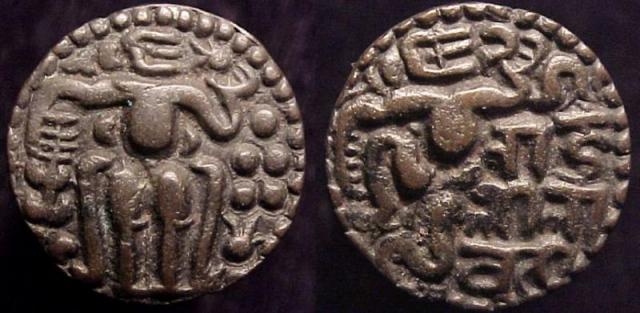Tamils in Sumatra: An Inscription January 11, 2015
Author: Beach Combing | in : Medieval , trackbackInscriptions come in many shapes and sizes from graffiti scratched in Romanesque churches, to the huge stone book of Gal-Potha in Sri Lanka, to the panel recalling the first Chinese Christians. However, in Beach’s endless quest to hunt down the bizarre he recently stumbled upon this classic. It was found in Sumatra and was put up by a Chola merchant guild, the Five Hundred Lords of Ayyavole, in 1055. If you have no idea who the Cholas are, then, that was also a problem for this blogger. Ignorance over, it transpired that they were a medieval people dwelling in the Kaveri valley in southern India. Tamils in Sumatra c. 1000…. You should already be getting shivers… Anyway, here is the text. It comes dangerously close to being a Monty Python sketch.
Famed throughout the world… born to be wanderers over many countries, the earth as their sack, the eight regents at the points of the compass as the corner tassels, the serpent race as the cords, the betel pouch as a secret pocket, the horizon as their light… and by land routes and water routes penetrating into the regions of the six continents, with superior elephants, well-bred horses, large sapphires, moonstones, pearls, rubies, diamonds, lapis lazuli, onyx, topaz, carbuncles, coral, emeralds and various such articles: cardamoms, cloves, sandal, camphor, musk, saffron and other perfumes and drugs, by selling which wholesale or hawking about on their shoulders, preventing the loss by customs duties, they fill up the emperor’s treasury of gold, his treasury of jewels, and his armoury of weapons; and from the rest they daily bestow gifts on pundits and munis; white umbrellas as their canopy, the mighty ocean as their moat, Indra as the hand-guard of their swords, Varuna as the standard bearer, Kubera as the treasurer, the nine planets as a belt… the sun and moon as the backers, the 33 gods as the spectators… clay they set fire to, of sand they make ropes; the thunderbold they catch and exhibit; the sun and moon their draw down to earth. they converse about the frontal eye and four arms of Isvarabhattaraka, the loud laughter of Brahma, and the madness of Bhagavati. [their trade is] a sack which bursts from the contents collected from the points of the compass, an assu which runs away (laden) with grain, a wounded and fallen body, a cart that has been seized, a tax that has been evaded, a cry of looting… a bargain that has been made, they are not one to fail; taking the head of an intruder as the tassel, they bind the enemy’s hand as a badge (on a pole), and parade about; gambling they will not allow; to a dead body they are good. (K.A. Nilakanta Sastri, ‘A Tamil merchant guild in Sumatra’)
What superb arrogance! The horizon as their light, the ocean their moat, the planets their belt AND they treat dead bodies with respect (unless they are enemies in which case they chop off hands). Nothing like free trade. Other fabulous inscriptions: drbeachcomb ing AT yahoo DOT com
18 Jan 2015: BT writes in ‘That stone inscription is in celebration of the victory of the Indian Chola Empire, which controlled parts of Sri Lanka, over the Srivijayan Empire, who controlled not only the Spice trade, but the China trade, the South China Sea and most of the Indian Ocean from the 7th to 11th century C.E. They had client states that stretched from Vietnam and the Philippines to Madagascar. The power of the Srivijayan’s was based on their core area ,Sumatra, most of Java, and the Malay Peninsula. They had an iron grip on the Malacca and Sunda straights along with the portage routes across the Malay Peninsula. If you wanted to trade for Chinese goods or spices from islands to the east of Java, you had to deal with Srivijayan’s. They and the Chola’s had good relations early on, both were maritime powers and trading partners. In roughly the late 9th century, relations between the two began to sour. After a series of wars, the cause of which are still murky,the Chola managed to defeat the Srivijayan’s in the Sumatran heart of the empire in 1006 CE. The Chola’s had not only defeated the richest state in Southeast Asia, but the most powerful sea power in the world. Who wouldn’t brag long and hard about it?’ Thanks Bruce
18 Jan 2015: Lehmansterms writes: Nine planets, Doc? – in the 11th century? Actually, the Cholas are well known to those with some knowledge of South Asian numismatics – their coins are quite distinctive and common, ie: relatively easily found – a partial measure of the affluence of the kingdom, due in no small measure, no doubt, to the merchants who boast of their glory in the Sumatran inscription you quote in your recent blog entry.
King seated facing holding tamgha in right hand, sun or star in left / Hanuman standing left (seems more like he’s dancing, to me). But I’m in danger of burying the lead here… What really struck me about the inscription – aside from the towering hubris – was the reference to “…the nine planets as a belt…” The number of planets was fairly universally recognized to be seven (including Earth) until the 19th century discovery of Neptune and the early 20th century discovery of the now de-planeted Pluto. It was nine planets counting Earth when I was in school (mid 20th century) as I assume it was held to be in your school days as well, and is now considered to eight again, with a number of “planetesimals” beyond the orbit of Neptune including Pluto among others – some larger than Pluto – that have recently been revealed by modern telescopy. So I wonder just what other celestial bodies aside from Mercury, Venus, Mars, Jupiter, Saturn and Uranus they are including in their count of nine planets? The Sun and moon, perhaps? They are definitely not “stars” in the sense of the tiny, fixed, nighttime points of light, so I suppose it’s possible, but the inscription goes on to say “the Sun and Moon as the backers…” (of the “nine planets as a belt”, presumably) so that seems to eliminate them from the count of planets. Even if they were being counted twice, what then would the ninth have been? Certainly not the Earth in even the Eastern astronomical tradition of the 11th century.It’s a poser, to be sure.




